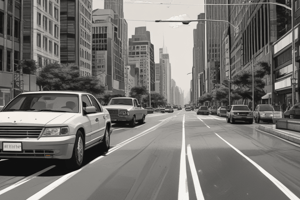Podcast
Questions and Answers
_____ occurs when a driver uses the vehicle or some other weapon to threaten or cause harm to another roadway user in response to a traffic incident.
_____ occurs when a driver uses the vehicle or some other weapon to threaten or cause harm to another roadway user in response to a traffic incident.
- Road rage (correct)
- Circadian rhythm
- Aggressive driving
- Micro-sleep
If you are driving and become fatigued you should:
If you are driving and become fatigued you should:
- Stop driving and get rest (correct)
- Play the radio at high volume
- Open the windows
- All of the above are correct
Drivers are at increased risk of becoming drowsy if they:
Drivers are at increased risk of becoming drowsy if they:
- Are shift workers
- Take long trips
- Are young drivers
- All of the above are correct (correct)
_____ occurs when water between the tires and the road builds until the tires begin to ride on a film of water, resulting in loss of traction.
_____ occurs when water between the tires and the road builds until the tires begin to ride on a film of water, resulting in loss of traction.
To avoid a collision, you can use:
To avoid a collision, you can use:
When you are driving and encounter heavy fog you should:
When you are driving and encounter heavy fog you should:
It is always illegal to drive on ocean beaches in Washington State.
It is always illegal to drive on ocean beaches in Washington State.
Your vehicle's operating space is:
Your vehicle's operating space is:
It is more difficult to steer if you fail to:
It is more difficult to steer if you fail to:
When you park on a hill facing uphill you should:
When you park on a hill facing uphill you should:
When backing:
When backing:
In Washington State, a driver must always stop for a school bus with its stop sign extended and red lights flashing.
In Washington State, a driver must always stop for a school bus with its stop sign extended and red lights flashing.
Total stopping time is made up of:
Total stopping time is made up of:
Anti-lock braking systems (ABS):
Anti-lock braking systems (ABS):
When driving, it is best to place:
When driving, it is best to place:
The first step to ensure the path behind the vehicle is clear prior to backing is:
The first step to ensure the path behind the vehicle is clear prior to backing is:
When you shift to reverse you should:
When you shift to reverse you should:
Signs communicate meaning using:
Signs communicate meaning using:
How often should the pre-driving checks identified for approaching the vehicle, checking the outside vehicle and checking the inside vehicle be performed?
How often should the pre-driving checks identified for approaching the vehicle, checking the outside vehicle and checking the inside vehicle be performed?
Flashcards are hidden until you start studying
Study Notes
Road Safety Concepts
- Road Rage: Aggressive behavior where drivers threaten or harm others due to traffic incidents.
- Driver Fatigue: If fatigued, the best action is to stop driving and rest.
- Drowsiness Risks: Increased risk factors include being a shift worker, taking long trips, or being a young driver.
Vehicle Handling and Traction Loss
- Hydroplaning: Occurs when water builds between the tires and road leading to loss of traction.
- Collision Avoidance: Techniques include evasive steering, braking, and acceleration to prevent accidents.
Driving Conditions and Regulations
- Heavy Fog Driving: Reduce speed and use low beam headlights for better visibility.
- Washington State Beach Driving: It’s not always illegal to drive on ocean beaches.
Vehicle Space and Positioning
- Operating Space: Includes front, rear, and side spaces around the vehicle.
- Steering Difficulty: Failing to maintain an upright seating position complicates steering control.
Parking Techniques
- Uphill Parking: Always set the parking brake and turn the wheels away from the curb.
- Reverse Maneuvering: Use proper seating positioning and check surroundings while backing up.
Traffic Signals and Safety Protocols
- School Bus Regulations: It is not mandatory to stop for a bus with extended stop sign and red lights in all cases.
- Total Stopping Time: Comprised of reaction time, braking time, and perception time.
Braking Systems and Techniques
- Anti-lock Braking System (ABS): Aids in maintaining steering control during hard braking, enhancing safety.
- Foot Placement while Driving: Position your foot in front of the brake before pivoting to the accelerator for smoother transitions.
Pre-driving Safety Checks
- Path Clearance: Always check behind the vehicle before entering to ensure the area is clear.
- Shifting to Reverse: Always press the brake pedal before shifting to ensure safety.
Signage Communication
- Traffic Signs: Convey meanings through color, shape, and words, ensuring drivers understand regulations and warnings.
Regular Vehicle Checks
- Pre-driving Checks: Conduct routine checks every time before driving to ensure vehicle safety and readiness.
Studying That Suits You
Use AI to generate personalized quizzes and flashcards to suit your learning preferences.




